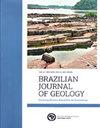Zircon U-Pb dating and petrogenesis of the São José do Campestre Granite Complex, NE Brazil: an example of neoarchean mantle-derived post-collisional magmatism
IF 0.9
4区 地球科学
Q3 GEOSCIENCES, MULTIDISCIPLINARY
引用次数: 0
Abstract
This article discusses the geochemical and petrological evolution of the São José do Campestre granite complex (SJCgr), the last Neoarchean plutonic event so far described in the São José do Campestre massif in NE Brazil. We report field, petrographic, zircon U-Pb dating, and whole rock and mineral chemistry for representative SJCgr samples. Laser ablation zircon U-Pb data indicate that the granite emplacement took place at 2664 ± 13 Ma. The rocks comprising the SJCgr have relatively well-preserved primary textures and fabrics and compositions varying from gabbro to syenogranite. Major and trace element contents reveal a metaluminous, calc-alkaline through transitional to alkaline signature, and LILE-and LREE-enriched series analogous to late Archean sanukitoid and modern arc granitoid. The evolution of the SJCgr is envisaged as follows: (1 st ) partial melting of a metasomatized mantle (2.5–3.0 GPa, ~85–102 km, 1,000–1,200°C), generating a basaltic to basaltic andesitic magma; (2 nd ) fractional crystallization (FC) of olivine at mantle or lower crustal depth, leading to the parental magmas of the magmatic series; and (3 rd ) 40– 15% FC of olivine gabbro-norite and olivine monzonite cumulates (400–600 MPa, 15–23 km). The SJCgr shares similarities with post-collisional granitoids and, thus, would represent the last Neoarchean episode of mantle-derived magma in Northeastern Brazil.巴西东北部 o jos do Campestre花岗岩杂岩的锆石U-Pb定年和岩石成因:新太古代幔源后碰撞岩浆活动的一个例子
本文章由计算机程序翻译,如有差异,请以英文原文为准。
求助全文
约1分钟内获得全文
求助全文
来源期刊

Brazilian Journal of Geology
GEOSCIENCES, MULTIDISCIPLINARY-
CiteScore
3.20
自引率
7.10%
发文量
12
审稿时长
11 weeks
期刊介绍:
The Brazilian Journal of Geology (BJG) is a quarterly journal published by the Brazilian Geological Society with an electronic open access version that provides an in-ternacional medium for the publication of original scientific work of broad interest concerned with all aspects of the earth sciences in Brazil, South America, and Antarctica, in-cluding oceanic regions adjacent to these regions. The BJG publishes papers with a regional appeal and more than local significance in the fields of mineralogy, petrology, geochemistry, paleontology, sedimentology, stratigraphy, structural geology, tectonics, neotectonics, geophysics applied to geology, volcanology, metallogeny and mineral deposits, marine geology, glaciology, paleoclimatology, geochronology, biostratigraphy, engineering geology, hydrogeology, geological hazards and remote sensing, providing a niche for interdisciplinary work on regional geology and Earth history.
The BJG publishes articles (including review articles), rapid communications, articles with accelerated review processes, editorials, and discussions (brief, objective and concise comments on recent papers published in BJG with replies by authors).
Manuscripts must be written in English. Companion papers will not be accepted.
 求助内容:
求助内容: 应助结果提醒方式:
应助结果提醒方式:


